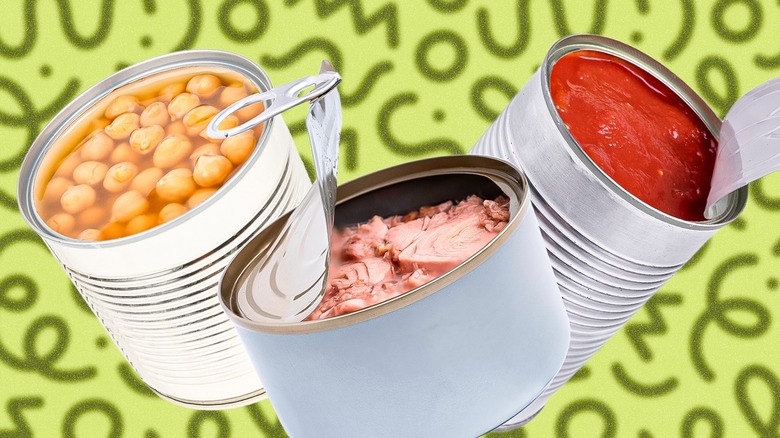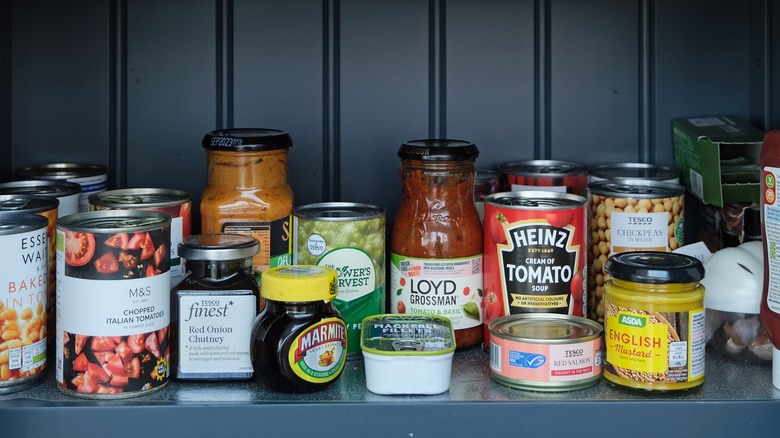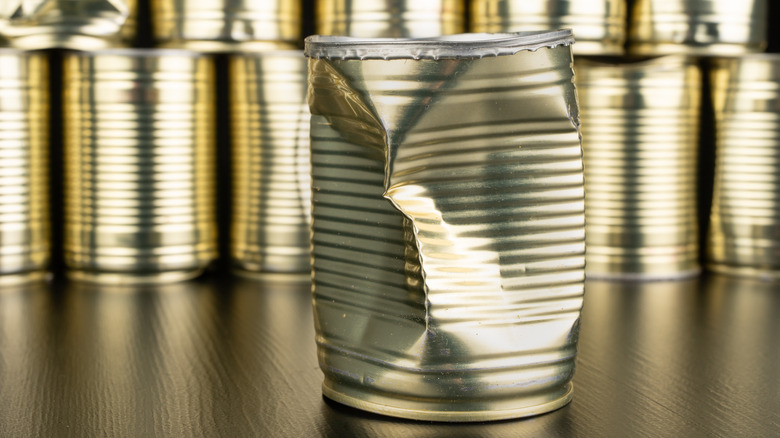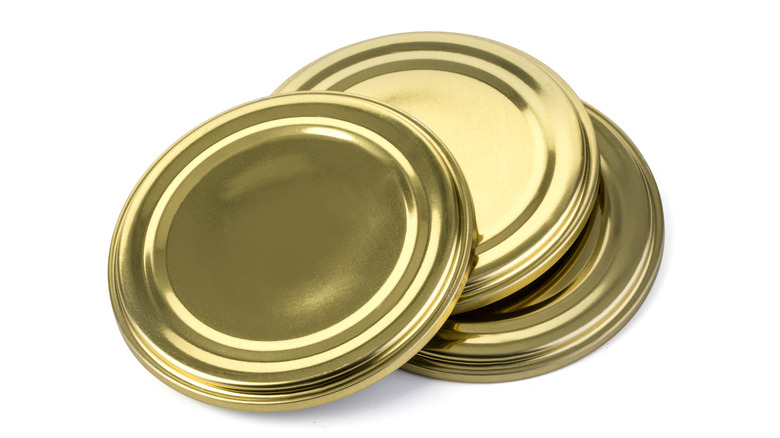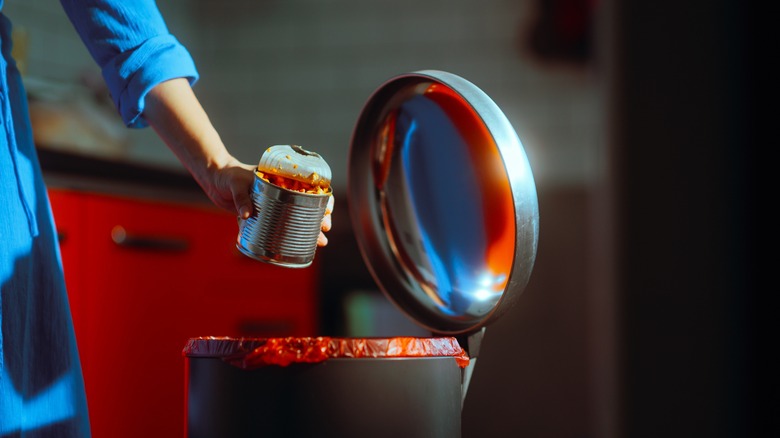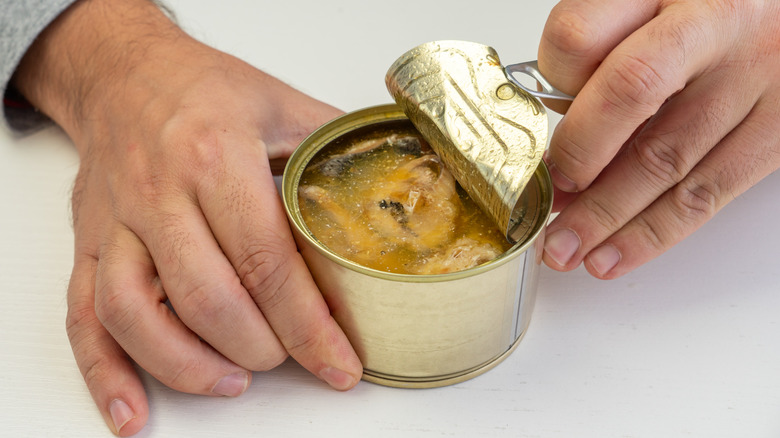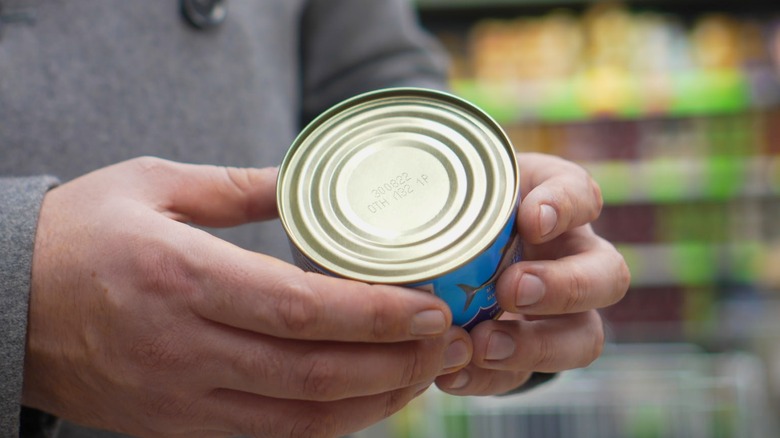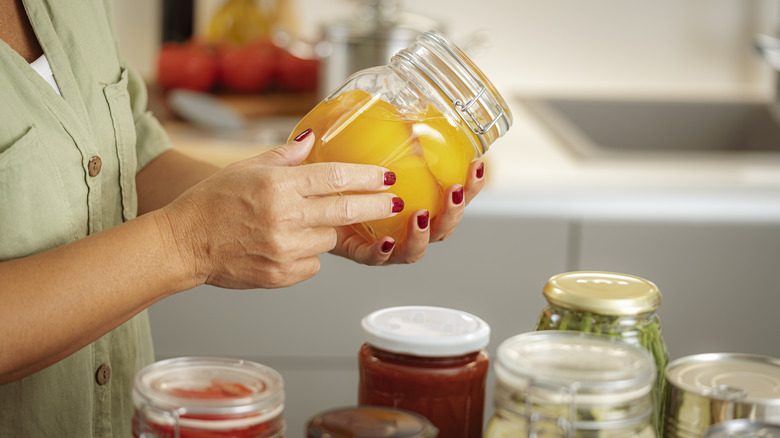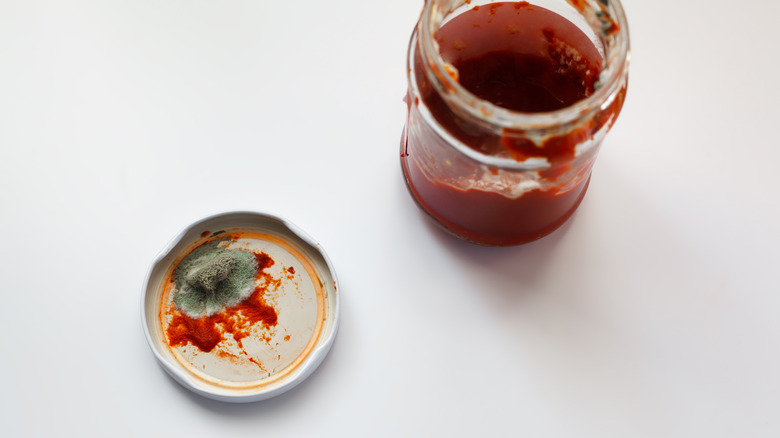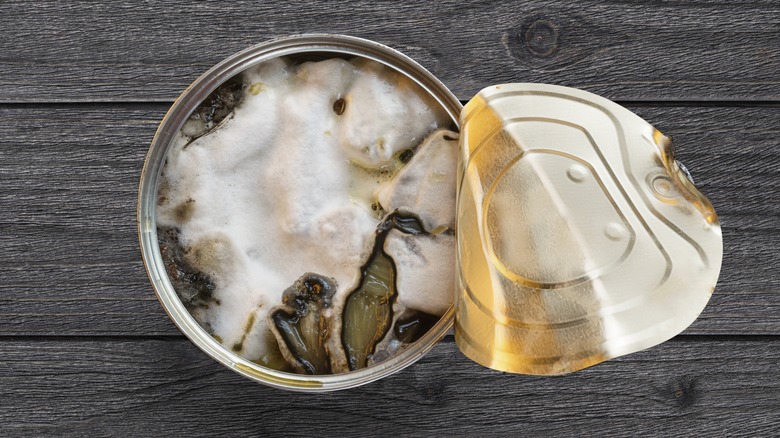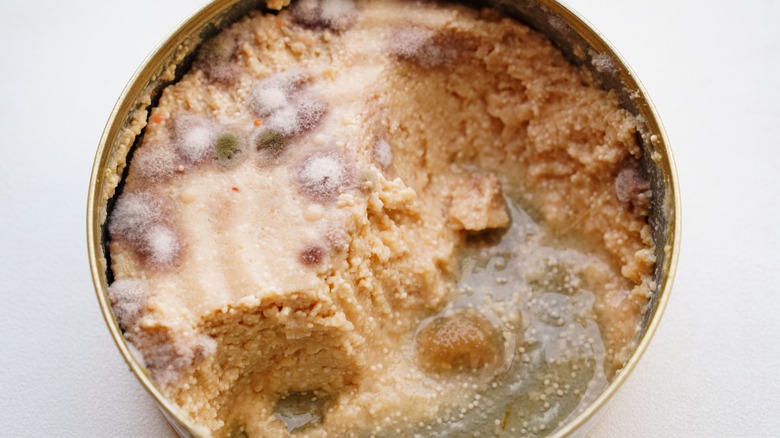10 Telltale Signs Your Canned Goods Have Gone Bad, According To A Seasoned Chef
When it comes to essential pantry staples, canned goods sit at the top of the list. In many ways, canning makes kitchen life easier (even for celebrity chefs like Ina Garten). Canned goods are more affordable, have a seemingly endless shelf life, and offer new flavorful possibilities for everyday foods. What's more, they're the best time-savers around. Don't let myths about salt in canned goods deter you from using them more in your cooking. From canned beans and veggies to meats, many of those myths have long since been debunked.
Canned goods go bad like any other food. Whether you stick to basic goods or do your canning at home, you should know how to spot signs of spoilage. After all, it's hard to tell if a can has expired without knowing what to look for, especially if the can appears intact. You finally found the perfect recipe for those canned hearts of palm only to discover them spoiled? That sucks, but fortunately, it's totally avoidable. There are a few indicators that, once known, will keep your canned goods in tip-top shape.
To ensure that we covered all of our bases, we asked professional chef Justin Simeon to assist. He has over 20 years of experience as a private chef and is the current chef de cuisine at Alta Adams, a Los Angeles-based soul food restaurant. With his guidance, we're going to show you the telltale signs that your canned goods have gone bad.
Improper storage temperature
Improper food storage is more common than you think. Canned goods are built to last, but to ensure a long shelf life, you have to store them in the right conditions. Pantries and cabinets are ideal storage spaces for several reasons. They shield canned goods from direct sunlight and offer the perfect temperature setting. When you're storing canned goods, exposure to prolonged sunlight can heat the cans' contents and cause spoilage. The same goes for humidity and storage spaces with fluctuating temperatures. If you live in a city with extreme weather, be mindful of the changing seasons.
Humidity can invite rust and mildew, which can grow into mold in damp spaces. If the temperature fluctuates between hot and cold, the contents will as well. "Temperature is a key factor in the preservation of canned foods," Justin Simeon told Tasting Table. "They should be kept in a cool and dry environment. Do not exceed storage temperatures above 75 degrees Fahrenheit." To be clear, "cool and dry" does not mean cold. It refers to the natural room temperature of a sunless storage space. (Also, if you're a stickler for aesthetics, sunlight has the undesirable effect of fading labels.)
Leaks, big bulges, or bad dents
If a canned good has any noticeable leaks, bulges, or dents, there's a decent chance it may have gone bad. Significant structural damage indicates the potential presence of Clostridium botulinum contamination, which, per the USDA, is a type of toxic bacteria responsible for botulism, a potentially life-threatening disease. C. botulinum can survive in low-oxygen conditions for years, and canned goods are ideal breeding grounds. The toxin that it produces is extremely rare, but even a tiny amount can cause sickness or death. Though botulism is primarily linked to home-canned foods, store-bought canned goods are also susceptible.
Small dents can also be problematic. "Dented cans may have an unseen hole or crack that can lead to rust, oxidation, and bacterial growth," Justin Simeon told Tasting Table. Bacteria shouldn't be an issue, though, if the can is intact. Canning was invented long before can openers, so that should allay any concerns about their safety. When buying canned goods in the future, however, you'd be smart to avoid the flawed cans altogether. Treat your cans with care and you'll be stocked for months to come.
Loose or bulging lids
A loose or bulging lid is another telltale sign of bacteria contamination. When your pantry is stocked with the absolute best canned foods, the last thing you want is to find them spoiled. Bacterial growth causes gas to build up inside the can, which creates pressure that pushes outward in an attempt to escape. Aluminum cans are generally pliant, but when foods are home-canned in glass containers, contamination is trickier to pinpoint. Unless the contents are noticeably spoiled, you'll have to check to see if the lid is loose or bulging.
As Justin Simeon explained, "Bulging lids are a sign of gasses being released from bacteria. Loose or popped lids are a sign of improper sealing during canning, [or that] the can or jar has been opened, or there is a crack or leak in the container. A correctly sealed jar should make a popping noise when opened." In fact, that's why button-style lids were invented. You're likely used to seeing them on juice products or the popular two-piece variety on mason jars. The button lid lets you know if the container has been tampered with but also if the contents have expired. That said, canned goods are pressurized and vacuum-packed, so it's perfectly normal to hear a hissing suction sound when you open them.
Liquid squirting out when you open the can
The next telltale sign to look out for is liquid or foam squirting out when you open a can, as this could indicate Clostridium botulinum or bacteria contamination. Most canned foods contain liquid. According to a 2013 study by Consumer Reports, liquid in canned goods can account for almost 43% of the weight listed on the label. A can's net weight refers to the food and the liquid content. The USDA has different liquid-to-food requirements for different canned goods, according to the Consumer Reports study, but the liquid content still varies from brand to brand.
As we've established, contamination creates gas. The additional pressure buildup in the container will send liquid flying once the can is opened. "Liquid squirting from cans being opened is a sign of spoilage," Justin Simeon explained, adding, "Air rushing out, bad. Air rushing in, good." Even still, sometimes pressure buildup is so intense that it can cause liquid to leak out. Cans with liquid stains that are seemingly intact might have tiny holes and should immediately be tossed.
Strange or funky aromas
If a canned good has a funny aroma, it's probably not wise to eat it. Upon opening a can, you should only smell the food product itself. If there are any noticeable vinegary, sour, metallic, or otherwise odd aromas, toss the can out, as those are all red flags. Spoilage occurs not only due to bacteria but also because of yeast and mold. Yeast is usually found in pickled and fermented products, which are considered high-acid canned foods. This creates carbon dioxide, which causes swelling. Mold, on the other hand, is most conducive to high-acid sugary foods like jam, jelly, marmalade, and ketchup. Bacteria is the most notorious offender and can infiltrate every type of canned good, from low- to high-acid.
Clostridium botulinum contamination is invisible and has no taste or odor. Aroma doesn't indicate whether the toxin is present, but if something seems off, you should always trust your instincts and throw out the food without eating it. It's not worth the risk, and anyway, canned food is relatively affordable. As Justin Simeon explained to Tasting Table, "Your sense of smell is the second line of defense against spoiled foods. Trust your gut."
Years have passed since you purchased the can
Waiting past the expiration date to open a can of food can feel like a game of Russian roulette. Canned food lasts a long time, no doubt, but just how long, exactly? That depends on several factors. We've covered the importance of a cool, dry storage space and a can's structural integrity, but the type of canned food you're dealing with also matters. "Many canned foods can last past their 'Use By' [or] 'Best Before' date," said Justin Simeon. The expiration date isn't always the best indicator of freshness — even canned chicken can last longer than expected. (In case you're interested, here are some more canned chicken myths you should stop believing.)
According to the USDA, high-acid canned products stay at peak quality for about 18 months. Low-acid ones last between two and five years with proper storage. What's interesting is that food product dating has nothing to do with when the food expires; rather, it refers to how long the food will stay at peak quality, and it notifies stores when to replace old cans with fresh ones. The bottom line is, dates are less about safety than they are about taste. That's why whenever you open a can, you should always inspect it for defects or signs of contamination.
The jar is cracked
Glass jars have several advantages over aluminum cans in terms of spoilage. For one thing, they make it easier to spot bacteria, yeast, or mold growth. The material is also less pliant and therefore harder to compromise. Finally, the food won't spoil due to any chemical reactions with metal. In general, if done properly, you needn't worry about home-canned foods as they age. Nonetheless, these goods have a higher risk of contamination than the store-bought variety. In the U.S., botulism outbreaks are mostly caused by home-canned vegetables.
There are, however, downsides to using glass over aluminum. While it's easier to spot spoilage through glass, transparency also makes the food inside more susceptible to direct sunlight. You may unintentionally fast-track bacterial growth if you store them incorrectly. Additionally, glass jars are sturdy but far from unbreakable. If botulism contaminates the jar, gaseous expansion may cause cracks in the glass. If you're new to home canning, the National Center For Home Food Preservation has a complete guide with step-by-step instructions for how to home-can properly — and, most importantly, safely.
Tiny gas bubbles are forming
Glass jars allow you to pinpoint early warning signs of spoilage. Since contamination growth produces gas, you're able to clearly see the formation of gas bubbles. Air bubbles are fairly common during the home-canning process, as removing them completely is difficult, but you mustn't confuse these with gas bubbles. Static bubbles are normal — it's the fizzy ones that you need to watch out for. If you've followed the proper safety steps and have sealed the lid airtight, you should be okay.
"Tiny pockets are fine as long as they are stationary," Justin Simeon told Tasting Table. He went on to explain, "If the bubbles are moving from top to bottom, that is a sign of bacteria or fermentation. If a jar or can is opened and it starts to fizz or foam, the contents may have been compromised." Even if you've properly prepared your kitchen for canning food, bacteria may still slip by undetected. That's why it's important to check on your home canned goods every now and then.
Discoloration or mold
We've briefly discussed mold and its ideal growth conditions in canned goods. Four species of mold commonly contaminate canned foods: Aspergillus, Byssochlamys, Penicillium, and Citromyces. According to Mold Removal Express, Penicillium and Aspergillus are two of the most dangerous mold species. No matter the type, though, it's always best to avoid mold. Fortunately, pretty much everyone is familiar with its off-colored look, rank odor, and furry texture, so it's hard to miss.
Along with mold, food discoloration is another telltale sign of canned goods gone bad. There are many potential causes of food discoloration. When oxygen comes into contact with the enzymes in fruits and vegetables, it creates a reaction called "enzymatic browning," which, fittingly enough, browns the color. Oxidation also impacts color, along with exposure to high temperatures, which can break down pigments in food. Another cause is the natural acidity in foods with high pH levels. Additionally, sunlight exposure and metallic reactions may also be causes. Whatever the culprit, if your canned food is even slightly discolored, it's better to be safe and throw it away.
Odd texture changes
Like any other food, spoilage affects the texture of canned goods, too. It's natural for a food's consistency to change over time, but if it becomes slimy, overly mushy, or simply unusual, it's likely inedible. Textural changes are most common in high-acid canned foods like salsa, tomatoes, pickles, and jellies. These contain natural chemicals that react with the metallic container, gradually impacting the food's taste, consistency, and nutrients. Contrary to popular belief, canned goods do not contain less vitamins than fresh. In fact, they can sometimes be a more nutritious alternative, as long as they aren't spoiled.
Extreme temperatures are another cause of texture changes in canned food. As a rule of thumb, you should never freeze canned goods (including sodas). If your pantry reaches sub-zero temperatures in the winter, the frozen contents will not only expand the can, but once the food thaws, the texture will soften even further. You should avoid storing cans in high heat for similar reasons — besides making food spoil faster, heat can dry out the contents. "Evaporation of liquid may be a sign of the container being compromised," Justin Simeon told Tasting Table. At the very least, canned food should always look the way it's described on the label.
